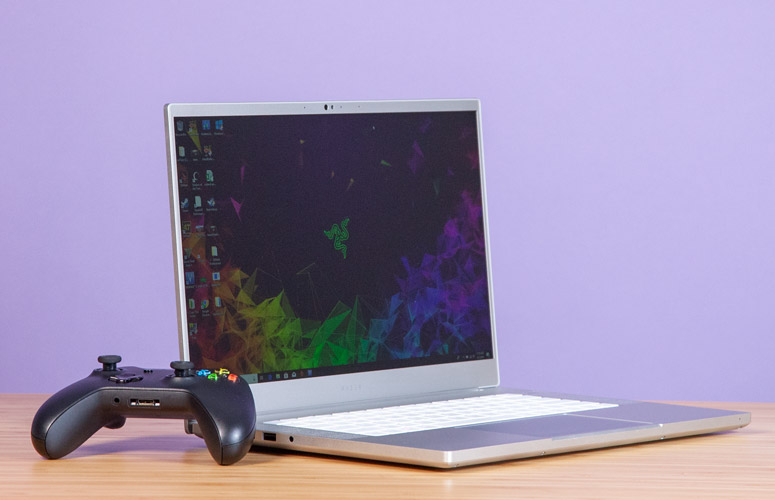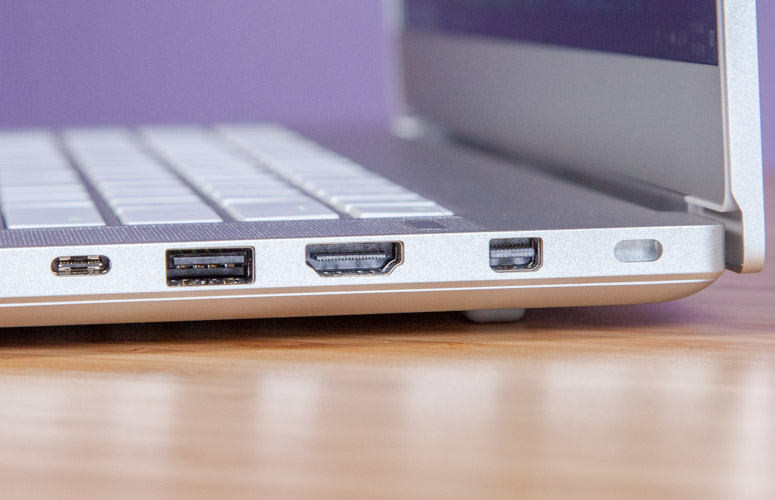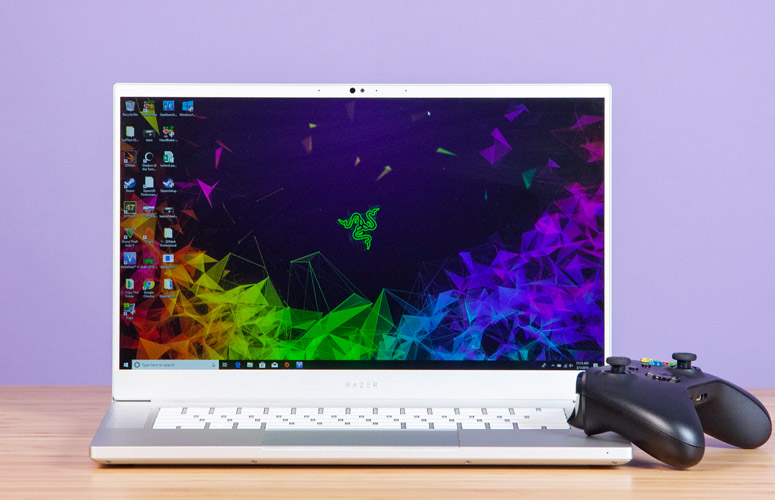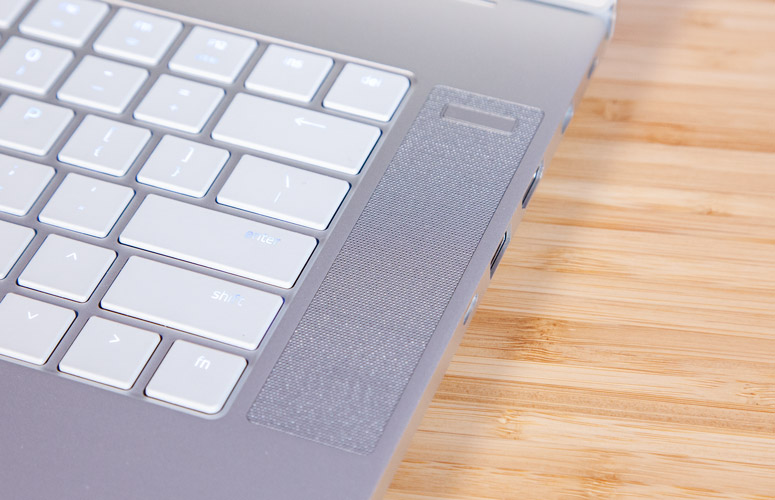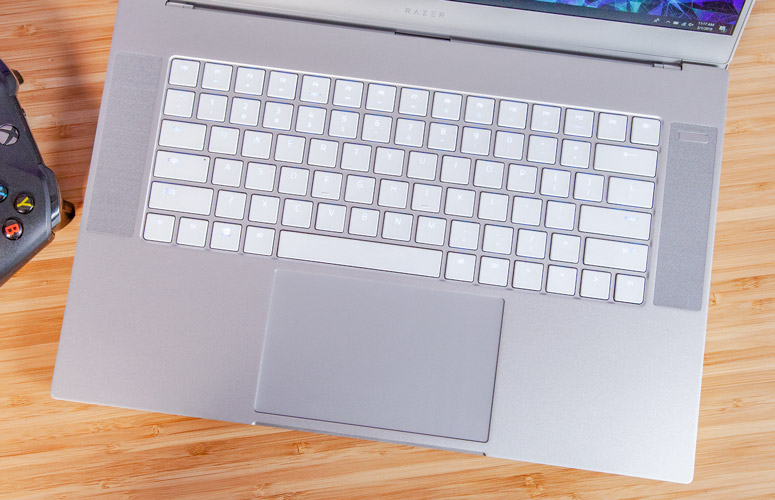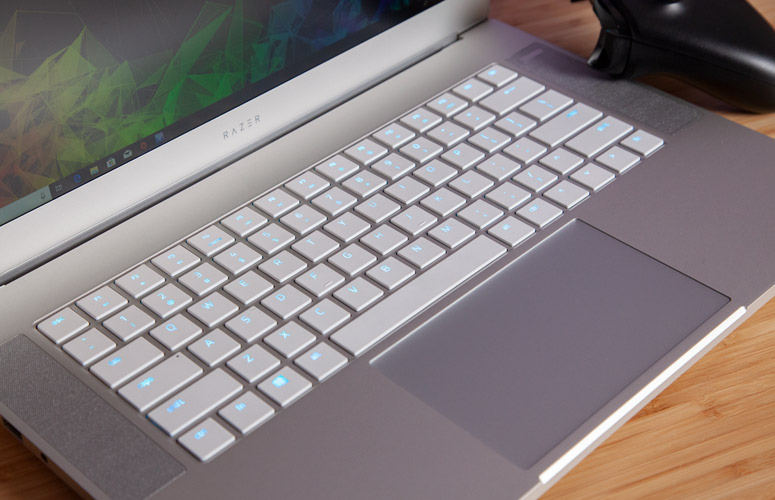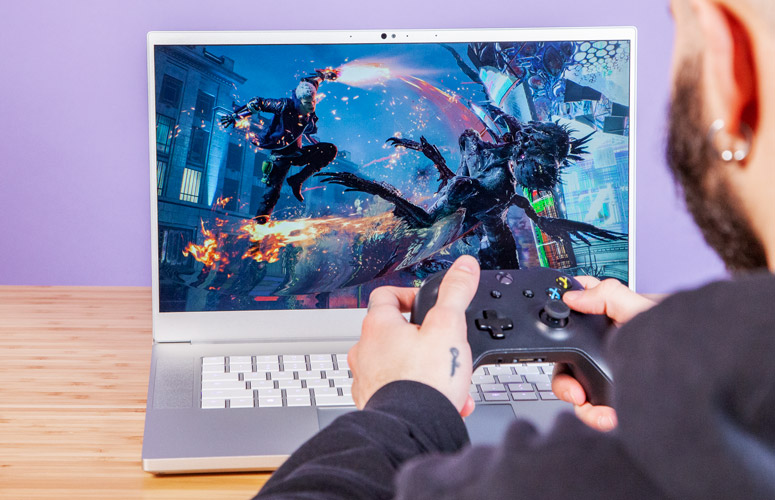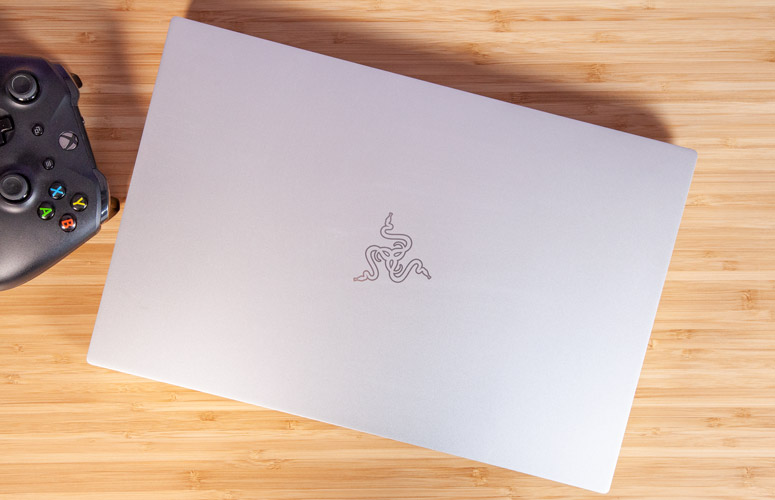Laptop Mag Verdict
The Razer Blade 15 offers a stunning design, powerful performance and solid battery life, but the display could be brighter.
Pros
- +
Beautiful, head-turning design
- +
Powerful graphics and overall performance
- +
Solid battery life
- +
Fast transfer speeds
Cons
- -
Dim display
- -
Weak audio
- -
Runs hot when gaming
Why you can trust Laptop Mag
Editor's Note 7.19.21: Laptop Mag doesn't generally recommend laptops two years or older. If you're in the market for a new Razer Blade 15 please check out our reviews on the Razer Blade 15 Base Edition (2021) and Razer Blade 15 Advanced Model (2021).
Here's what I like about Razer: As I keep getting older, they keep getting prettier, and stronger and faster. The company's latest offering, the Blade 15, is available in a stunning white chassis that's sure to draw every eye in the room. But as pretty as the exterior is, you'd be remiss to ignore the interior. Powered by an Intel Core i7 processor and one of Nvidia's new RTX GPUs, the Blade 15 is power personified. It even earned its spot on our Best VR-Ready Laptops page. However, a rather dim display keeps the Blade 15 from rising higher in the ranks.
You can also check out our face off between the Razer Blade 15 and the Aero 15 Classic.
Design
Razer's laptops have always looked great. Those ink-black aluminum chassis never ceased to incite a thrill in me. But now that Razer's started playing with color, I have only one question, What took you so long? The Mercury White version of the Blade is a vision in silvery alabaster. And usually I'd complain about the lack of logo backlighting, but I'm loving the way the gleaming embossed emblem reflected every color in its vicinity, particularly the bubblegum pink Razer Krakens perched on my desk.
With Mercury White, Razer is inviting even more pointed comparisons to Apple's MacBook Pro -- they're both silver and sleek, without a need or want for adornment. But in some ways, the Blade out-Apples Apple. There's no unsightly bezel surrounding the Blade's display, just slim metal bezels. And of course, you have those pristine white keys accentuating the pulsating rainbow of individual LEDs. No, this is a Razer through and through.
But where Razer really apes the MacBook and 15-inch gaming systems is in its size. The 4.7-pound, 14 x 9.3 x 0.7-inch Blade 15 is one the smallest 15-inch gaming systems you can get on the market. Sure, the 15-inch MacBook Pro (4 pounds, 13.8 x 9.5 x 0.6 inches) and the MSI GS65 Stealth Thin (4.1 pounds 14.1 x 9.8 x 0.7 inches) are lighter, but you can easily fit the Blade 15 on each system with plenty of room to spare. And at 4.8 pounds, 14.3 x 10.8 x 0.8~0.7 inches, the Alienware m15 is the largest of the bunch.
Sign up to receive The Snapshot, a free special dispatch from Laptop Mag, in your inbox.
Razer 15 price and configurations
I had an inordinately good time reviewing the $2,649 Advanced Model of the Mercury White Razer Blade 15. It comes with a 2.2-GHz Intel Core i7-8750H processor, 16GB of RAM, a 512GB NVMe PCIe SSD, an Nvidia GeForce RTX 2070 Max-Q GPU with 8GB of VRAM with an Intel UHD Graphic 630 GPU and a 1920 x 1080 panel with a 144Hz refresh rate. For $2,899, you can upgrade the screen to 4K at 60Hz.
Want the crème de la crème? Check out the $2,999 model with its black metal chassis and GeForce RTX 2080 Max-Q GPU with 8GB of VRAM.
MORE: Best and Worst Laptop Gaming Brands
The $1,599 base model has a 2.2-GHz Intel Core i7-8750H CPU, 16GB of RAM, and a 128GB SSD with a 1TB 5,400-rpm hard drive. You also get an Nvidia GeForce GTX 1060 Max-Q GPU with 6GB of VRAM with an Intel UHD Graphics 630 GPU and a 1920 x 1080 panel at 60Hz refresh rate.
Ports
For a notebook with dimensions as slim as the Blade 15, it manages to fit a surprising number of ports.
For example, you have a USB 3.1 port, a Thunderbolt 3 port, an HDMI 2.0. a mini DisplayPort and a Kensington Lock slot on the right side. And on the left are another two USB 3.1 ports, a headset jack and the proprietary power port.
You won't find a memory card slot, though.
Display
The color on the Blade 15's matte, 15.6-inch display is just as striking as its chassis. However, I wish the 1920 x 1080 panel was a tad brighter. When I watched the trailer for the upcoming Shaft movie, I was captivated by the trio of maroon dusters blowing heroically in the wind as three generations of the titular character walked across a plaza. Details were so crisp that I could clearly read see the word Shaft stamped across a speeding 9mm bullet, as well as the stippling from the gun of the battle.
The panel has a 144-Hz refresh rate, which should cut down on motion blur and jagged images. At least it did while I was playing Battlefield V, which allowed me to quickly blast an enemy soldier in the chest with my shotgun before doing a 180 and tagging another enemy in the back.
The display can reproduce an impressive 149 percent of the sRGB color gamut, which explains the vivacious hues. It's almost on a par with the m15 and the Stealth, which measured 150 percent and still topped the 140-percent premium gaming laptop average.
MORE: Best Graphics Performance
Averaging 262 nits of brightness, the Blade 15's display missed matching the 279-nit category average. The screens on the Alienware m15 and the MSI Stealth were much brighter at 284 and 293 nits.
Audio
The Blade's top-firing speakers are clear, but not as loud as I would like. Even at top volume with the Dolby Atmos software enabled, the laptop barely filled our lab space. I could even hear the newscast our product tester was listening to.
Still, the audio is pretty clean. I could hear songstress Tamia switch between alto and soprano without losing the timbre of the piano chords as she sang. The low end on Black Thought's "Fentanyl" was lacking, however, which is a shame, because the other percussion was so crisp.
MORE: The Best Headsets for Immersive Gaming
The gunfire wasn't as loud as I would have liked as I did a run-and-gun to an enemy airfield, and the explosions didn't have the oomph that I expected. Still, once the mission got going and the violins gradually increased in volume, I was fully immersed in the game, fighting to complete my mission.
Keyboard and touchpad
Razer's ultra-low profile island-style keys are a bit of a mystery to me. With a 1.2 millimeter key travel (1.5mm is our minimum) and 68 grams of actuation force (60 g minimum), the keys aren't clicky, but they're not mushy, either. They definitely feel better than the keys on my work-issued MacBook Pro. And with that per-key RGB lighting, they look better, too.
I hit my usual 70 words per minute on the 10FastFingers typing test. My fingertips still felt good after 2 hours of typing, despite the shallow key travel. After passing the laptop around among my officemates for them to try out and comment, my colleague Andrew Freedman said it best, "It splits the difference between being good for typing a paper and serious gaming."
Razer outfitted the Blade 15 with a massive 5 x 3-inch Precision touchpad. My fingertips slid effortlessly over the smooth glass surface. The touchpad delivered fast and accurate responses to gesture inputs, including pinch-zoom, two-finger scroll and three-finger tap.
Synapse 3.0
I'm reviewing what Razer calls the Advanced Model, which, in addition to more powerful specs, also lets you customize each key with its own individual lighting effect. The magic happens in the company's Synapse 3.0 software. A cloud-based software, Synapse allows you to create customize lighting effects for the keyboard as well as create macros. You can also make profiles that launch with specified games or apps.
A newish Synapse feature lets you adjust system performance. There are three modes: Balanced, Gaming and Creator. Balanced gives you the optimal performance for battery life and overall performance, while Creator and Gaming increases power to the CPU and GPU, respectively. Each of these settings lets you toggle fan speed and the screen refresh cap.
Gaming, graphics and VR
The next generation in graphics cards is here, and it comes bearing gifts of ray tracing and artificial intelligence. Nvidia's new RTX chips are faster and more powerful than previous generations and have the added benefit of ray tracing, which makes games look photorealistic, and DLSS (Deep Learning Super-Sampling), which renders high-quality graphics using a variety of shortcuts that translate into graphics and performance improvements.
That means that when I played Battlefield V, the Blade 15's Nvidia GeForce RTX 2070 Max-Q GPU with 8GB of VRAM delivered a buttery-smooth 95 frames per second. So when I shot the explosive barrel positioned behind a pair of enemy soldiers, their bodies went flying ever so gracefully towards kingdom come.
The Blade 15 had a strong showing on all of our gaming benchmarks, starting with Rise of the Tomb Raider, where it notched 56 fps. It's below the 63-fps premium gaming laptop average, but more than enough to surpass the Alienware m15 (49 fps) and the MSI Stealth (44 fps) with their last-gen GTX 1070 Max-Q GPUs.
When I played Battlefield V, the Blade 15's Nvidia GeForce RTX 2070 Max-Q GPU with 8GB of VRAM delivered a buttery-smooth 95 frames per second.
During the Hitman test, the Blade 15 tied the 96-fps average, beating the Stealth and m15, both of which scored 79 fps.
The Blade 15 also matched the 76-fps Grand Theft Auto V category average, easily defeating the m15 and the Stealth, which obtained 66 and 61 fps, respectively.
MORE: The Best PC Games to Play Right Now
On the Middle-Earth: Shadow of War benchmark, the Blade 15 reached 91 fps, cruising past the 87-fps average and the Alienware m15's 75 fps.
Performance
The Blade 15 isn't all play. Thanks to its 2.2-GHz Intel Core i7-8750H processor with 16GB of RAM, the laptop cut through all my multitasking like so much tissue paper. I watched an episode of The Dragon Prince on Netflix while running 22 additional Google Chrome tabs, some of which were streaming Twitch or YouTube or scrolling through my Tweetdeck. Despite the load, there wasn't a bit of lag to be found.
In some ways, the Blade 15 out-Apples Apple.
The Blade 15 continued performing, producing 22,379 on our overall performance test, Geekbench 4.1. It was just enough to beat the 22,276 premium gaming laptop average and the 18,046 put up by the MSI Stealth (Core i7-8750H CPU). The m15 and its Core i7-8750H CPU performed slightly better at 22,873.
When we ran our productivity test, the Blade 15 paired 65,000 names and addresses in 45 seconds, which is just a few seconds slower than the 0:42 average. However, it was much faster than the MSI Stealth and the Alienware m15, which clocked times of 0:54 and 1:03.
Loaded with a 512GB NVMe PCIe SSD, the Blade 15 is seriously fast. The laptop took only 8 seconds to copy 4.97GB of multimedia files, which translates to a file-transfer speed of 636.2 megabytes per second. It's faster than the 599.6MBps average and the Stealth's (512GB M.2 SSD) 193.3MBps. However, the m15 and its dual 1TB M.2 NVMe PCI SSDs delivered an incredible 1,017.9 MBps.
During the video-transcoding test, the Blade 15 took 12 minutes and 53 seconds to transcode a 4K video to 1080p. That's slower than the 9:55 average as well as the Stealth (12:01) and the m15 (9:51).
Battery Life
More power, less endurance. Thanks to its RTX Graphics, the latest version of the Blade 15 is more powerful than its predecessor, but at the cost of battery life. The 2019 Blade 15 lasted only 5 hours and 2 seconds. That's more than an hour less than its predecessor (6:09). But that time is still better than the 3:22 premium gaming laptop average. The Stealth and m15 were faster at 5:40 and 6:28, respectively.
Heat
For gaming laptops, particularly thin and lights, the hunt for the better cooling solution continues. For Razer, the answer lies in a slim copper vapor chamber, which the company says is more efficient than regular heat pipes. As the water transforms into vapor, the resulting heat is channeled away from important components via heat exchangers. From there, the dual fans blow the heat out the vents.
Still, there's only so much Razer can do to keep such a slim system cool in the heat of battle. After spending 15 minutes infiltrating an enemy base in Battlefield V, I measured the system's touchpad, keyboard center and undercarriage. I saw temperatures of 95, 104 and 123 degrees Fahrenheit. The last two results surpass our 95-degree comfort threshold, so be careful with it around your lap.
MORE: Great Balls of Fire: The Effects and Causes of Laptop Heat
Once the laptop cooled off, we ran a 15-minute full-creen HD video. The touchpad was a bit warm at 96 degrees, while the middle of the keyboard measured 89 degrees. The bottom of the aluminum chassis rose to 100 degrees.
Webcam
The Blade 15's 720p IR webcam gives you just enough detail, but it's not great. In my test shots, you could make out the individual strands of my locks, as well as the shift from orange to purple to dark purple.
However, there was a fuzziness that blurred the finer details of my face. It's passable for video chats and streaming in a pinch. It can also be used to unlock the system using Windows Hello.
Software and warranty
Razer knows that gamers want as clean a slate as possible when it comes to storage. Which is why outside of the typical Windows 10 bloatware you won't find too much clutter. There are some third-party editions, such as links for Netflix, Plex and Hulu. There's also PicsArt and a photo editor/collage app.
Outside of Synapse, Nvidia Experience will be the most helpful to gamers with its useful suite of utilities, including Battery Boost, Whisper Mode and Shadow Play.
The Razer Blade 15 ships with a one-year limited warranty. Check out how Razer fared on our Tech Support Showdown, Best and Worst Brands and Best and Worst Gaming Brands special report.
Bottom Line
Razer continues to raise the bar with its gaming laptops. For $2,649, you get the Advanced Version of the Razer Blade 15, which comes in a stunning white aluminum chassis. And measuring 14 x 9.3 x 0.7 inches, it's officially the smallest 15-inch gaming system on the block. But this is a svelte beast, as it packs l a Core i7 CPU and Nvidia's impressive new RTX GPUs. The notebook is ready to game, video edit, crunch numbers and more at the drop of a hat.
If you're looking to save a few dollars and get a better display and longer battery life, check out the $2,099 version of the Alienware m15. Just keep in mind that you'll be missing out on Nvidia's RTX graphics (for now). But if you're looking for a system that's supremely portable and powerful, the Razer Blade 15 is for you.
Credit: Laptop Mag
- Here Are the Best Gaming Laptops Under $1,000: Edition
- Gaming Laptops and Accessories - News, Reviews and Best Picks
- What to Look for in a Gaming Laptop - Buying Guide for Gamers
Razer Blade 15 (2019) Specs
| Bluetooth | Bluetooth 5.0 |
| Brand | Razer |
| CPU | 2.2-GHz Intel Core i7-8750H processor |
| Company Website | www.razer.com |
| Display Size | 15.6 |
| Graphics Card | Nvidia GeForce RTX 2070 Max-Q GPU/Intel UHD Graphics 630 GPU |
| Hard Drive Size | 512GB |
| Hard Drive Speed | n/a |
| Hard Drive Type | NVMe PCIe SSD |
| Highest Available Resolution | 3840 x 2160 |
| Native Resolution | 1920x1080 |
| Operating System | Windows 10 Home |
| Optical Drive | None |
| Optical Drive Speed | n/a |
| Ports (excluding USB) | Thunderbolt 3, Noble Lock, Mini DisplayPort, Headset, HDMI 2.0, USB 3.1 |
| RAM | 16GB |
| RAM Upgradable to | 32GB |
| Size | 14 x 9.3 x 0.7 inhces |
| Touchpad Size | 5 x 3 inches |
| USB Ports | 4 |
| Video Memory | 8GB |
| Warranty/Support | 1 year limited warranty |
| Weight | 4.7 pounds |
| Wi-Fi | 802.11 a/b/g/n/ac |
| Wi-Fi Model | Intel (R) Wireless-AC 9560 |

Sherri L. Smith has been cranking out product reviews for Laptopmag.com since 2011. In that time, she's reviewed more than her share of laptops, tablets, smartphones and everything in between. The resident gamer and audio junkie, Sherri was previously a managing editor for Black Web 2.0 and contributed to BET.Com and Popgadget.
